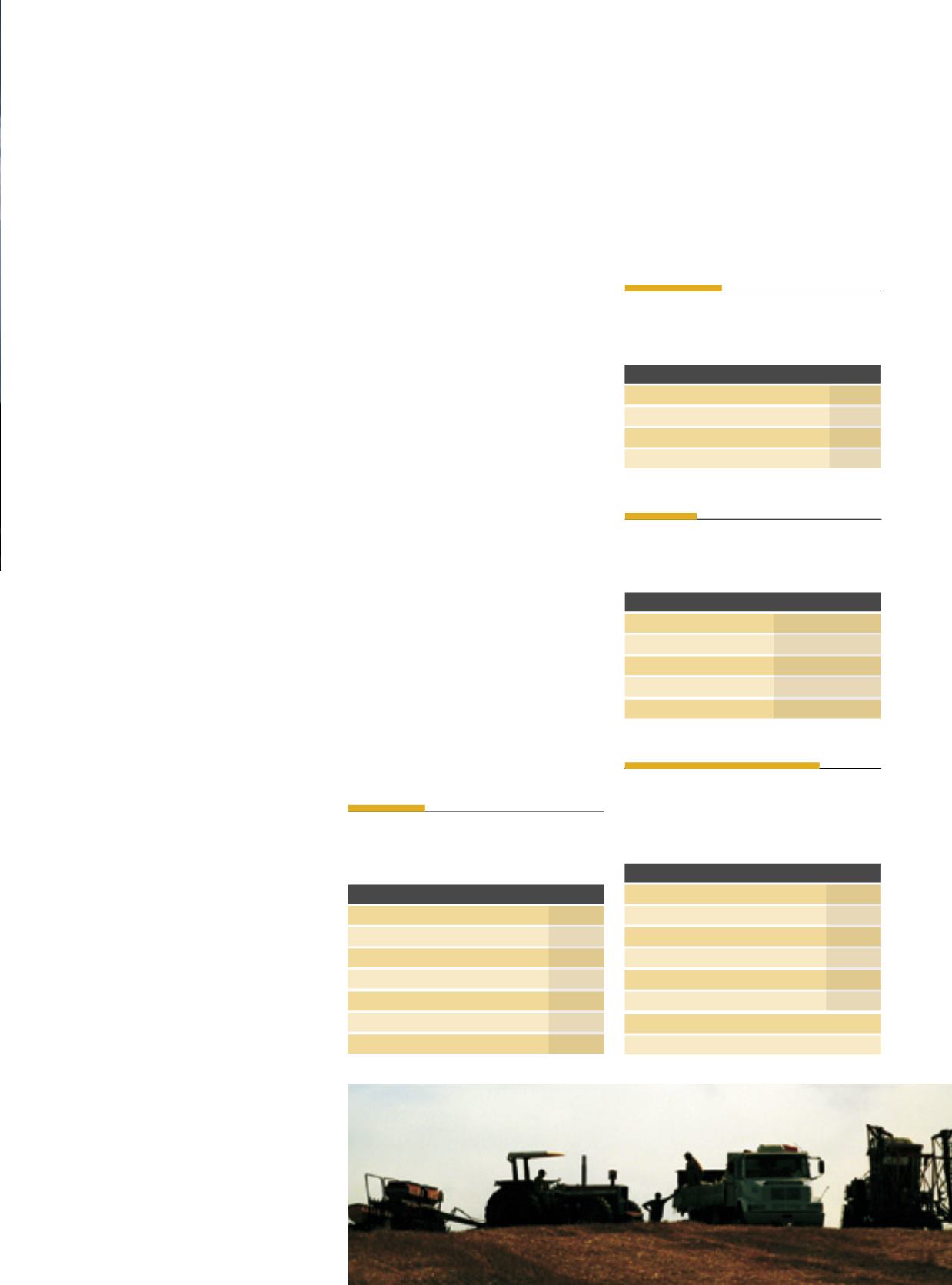
Stability as an
input
Segment projects 2018without big
growth alterations due to the political
scenario, to the high stocks and illicit trade
S
oybean reigns supreme in the
sales of products for vegetable
surveillance in Brazil. The crop
represents about 55.7%of all fun-
gicide, insecticide and herbicide
sales andother chemical products of the kind
utilizedfortheprotectionofplants.Cornranks
second, with 10.4%, including both summer
andwinter crops, followedby sugarcane,with
9.6%. In spite of the good performance of the
crop in the past years, the pesticide market
continuesstablethroughouttheCountry.
The distance between higher production
volumes and the sales of vegetable protec-
tionchemicalsstemsfromtwomajorreasons,
according to the executive director of the Na-
tional Union of the Vegetable Protection In-
dustry (Sindiveg), Sílvia Fognani. “As a result
of the economic downturn,many farmers de-
cided to lower their stocks. That is to say, they
refrained from buying the product. Another
topic is the illicit trade, which encompasses a
considerable chunk of the trade in the nation-
alterritory,withproductscomingmainlyfrom
Bolivia, ParaguayandUruguay”,shestresses.
For 2018, besides these two factors, Fog-
nani believes that two other elements will
have a say for the development of the sector:
China’s decision to shut down some factories
and the period of elections, facts that always
give rise to uncertainties. “In election years,
normally there ismuch concern about the fu-
ture. It is normal. We’ve got to be prepared.
With regard to China, the question is more
complexandaffectsourmarketstrongly.“,she
comments, insisting on the fact that since the
beginning of the year, hundreds of factories
were shut down in three Chinese provinces,
Hebei, Henan and Shandong. As a result, ac-
cording to Sindiveg officials, the volume and
costsoftheproductsimportedbyBrazilforthe
agricultural pesticide sector will suffer an im-
pact,generatingconsequencesforthefarmers
inthefinalvalueofthesales.
As far as fertilizers go, the performance
is similar. From January to November 2017,
some 32.08 million tons of the product were
brought into Brazil, according to the Nation-
al Fertilizer Association (Anda), up 2.1 percent
from the previous year. With regard to nutri-
ents, thedeliveryof nitrogen fertilizers (N)was
down 3.8% in the first 11 months of the year,
amounting to 3.7 million tons, a reflection of
the supply inadvance for thewinter corncrop
in late 2016, and a drop in supply for wheat
andsummercorncrop.
Phosphate fertilizer (P2O5) sales were up
1.4 percent over the same period, amounting
to 4.76 million tons, mainly destined for soy-
bean and cotton crops. Potassium fertilizers
(K2O) saleswere up 1.8 percent, reversing the
drop registered up to the end of September.
TheStateofMatoGrossoconcentratedthebig-
gest volume of deliveries fromJanuary toNo-
vember 2017, with 6.276million tons (19.5%),
followed by Rio Grande do Sul, with 4.06 mil-
lion (12.7%). São Paulo, with 3.98 million,
rankedasthirdbiggestconsumer(12.4%).
FOMENTO •
FOSTERING
As principais vendas
dedefensivos porcultura:
Cultura
%
Soja
55,7%
Cana-de-açúcar
9,6%
Milho Safrinha
7,3%
Algodão
4,8%
Milho Safra
3,1%
Café
2,5%
Pastagem
2,4%
Fonte:Sindiveg.
OESTADODODEFENSIVO
•
STATE LEADER INPESTICIDES
As principais vendasde
defensivos por Estado
Estado
%
MatoGrosso
20,4%
SãoPaulo
13,9%
Paraná
13,6%
RioGrande do Sul
13,2%
Goiás
9,6%
Minas Gerais
8,3%
MatoGrossodo Sul
6,0%
Bahia
4,6%
Fonte:Sindiveg.
CATEGORIAS •
CATEGORY
As principais vendasde
defensivos porclasse
Defensivo
%
Fungicidas Aplicação Foliar
32,4%
Inseticidas Aplicação Foliar
24,1%
Herbicidas Seletivos
17,1%
Herbicidas Não-Seletivos
15,4%
Fonte:Sindiveg
DE VALOR •
VALUE
Mercadodedefensivos
agrícolasnoBrasil
Ano
Valor (bilhões)
2013
US$ 11,45
2014
US$ 12,25
2015
US$ 9,6
2016
US$ 9,56
2017
US$ 8,8*
*Estimativa - Fonte:Sindiveg.
67


